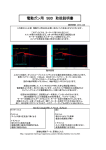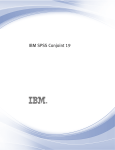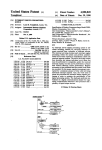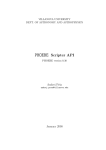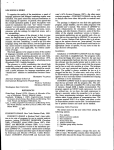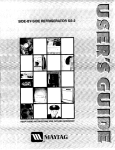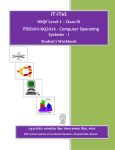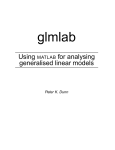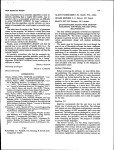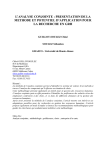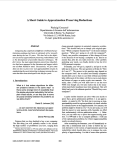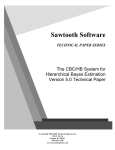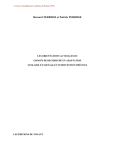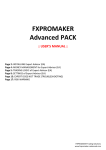Download RESELLER ASSORTMENT DECISION CRITERIA, Jerker Nilsson
Transcript
NEW BOOKS IN REVIEW RESELLER ASSORTMENT DECISION CRITERIA, Jerker Nilsson and Viggo Host. Aarhus, Denmark: Aarhus University Press, 1987, 176 pages. This softcover book contains an extremely detailed study of the relative importance of criteria used in reseller assortment decisions. As the authors state in the Preface, "The literature on reseller assortment decision criteria . . . consists mainly of descriptions of what criteria have been used in single reseller companies on certain occasions. What is lacking are explanations of how the resellers' criteria are related to the various situational factors." Their study seeks to remedy these shortcomings by focusing on situational factors ^ a t can affect the use of certain classes of decision criteria. The chapters are logically laid out with a preceding outline or introduction to each and an alphanumeric paragraph numbering system. A Summary chapter is provided at the beginning for readers not willing to work their way through the following five chapters. The study is written in a joumal article style that probably will not appeal to practitioners. Chapter 1, Problem, is a detailed, dissertation-quality, theoretical introduction to assortment decisions. The perspective is primarily that of the reseller, but all channel levels are discussed. Chapter 2, Literature Survey, continues the theoretical discussion with an extremely thorough review of the reseller assortment decision literature. Chapter 2 is continued in Appendix B, where 34 studies containing assortment decision criteria lists are reviewed in detail. Chapters 1 and 2 (plus the continuation of Chapter 2 in Appendix B) and the Bibliography fill 87 of the book's 176 pages. The theoretical discussion and literature review alone are worth the purchase price to any academician or graduate student researching reseller assortment decision criteria. Chapter 3, Empirical Bases, is a description of the data used in the study. The data were collected from a very large, vertically integrated organization of Swedish consumer cooperatives in 1975. The cooperative organization included more than 2300 retail outlets of several different types with a total assortment of more than 5000 items. The latter part of Chapter 3 includes the data collection instruments and procedures, as well as the variable specifications. Chapter 4 is the Statistical Analysis chapter. Multiple logit regression analysis was used to analyze the data because of the binary nature of dependent variables. This chapter includes a brief discussion of the logit model, selection of the explanatory variables, and goodness-of-fit measures. A more detailed matrix algebra description of binary choice models is contained in Appendix A. Chapter 5, Findings, describes the results of the data analysis in terms of both the seven decision categories and the 14 decision criteria studied. Conclusions are presented at the end of this chapter. This study is very well done, but it does not seem to be aimed at any particular market other than research 129 academicians and graduate students interested in reseller assortment decisions. The chief value of this book will be as a literature review and as an excellent example of how to organize and conduct dissertation-level research on a very large, complex database. The study represents an application of one particular method to one very focused marketing management decision area. The empirical results are probably not generaiizable to U.S. markets given the social and economic system from which the data were collected. This lack of generalizability, and the authors' dissertation style of writing, will probably preclude the book from appealing to practitioner markets. GEORGE C . HOZIER, JR. University of New Mexico SMARTFORECASTS II, Smart Software, Inc., Belmont, MA 02178. FORECAST PLUS, Walonick Associates, 6500 Nicollet Avenue South, Minneapolis, MN 55423. SPSS/PC+ TRENDS, SPSS Inc., 444 N. Michigan Avenue, Chicago, IL 60611. FORECAST MASTER, Scientific Systems, 35 Cambridge Park Drive, Cambridge, MA 02140. FOUR TIME SERIES ANALYSIS PACKAGES Four packages for analyzing time series data on PCs are reviewed here: SmartForecasts II (SMII), Forecast Plus (FP), SPSS/PC+ Trends (Trends), and Forecast Master (FM). The discussion follows the steps suggested by Box and Jenkins (1976): identification, estimation, and diagnosis. Identification is applied to the historical series with the objective of tentatively determining an appropriate model. Estimation refers to the task of estimating model parameters. Diagnosis is applied to the series of residuals with the aim of determining the appropriateness of the tentative model. The process is iterated as necessary. The capabilities of the packages in these respective areas are reported in Table 1. In this table, the term "diagnosis" differs somewhat from the its usage by Box and Jenkins. It refers to a set of tools—such as time plots or autocovariance function plots—that can be used to determine the sorts of models that might be appropriate for a series. "Preprocessing" refers to transformations that might be applied to a series to make it amenable to a particular estimation technique. For example, preprocessing might be done to a nonstationary series to make it stationary. Trends, seasonality, and varying autocorrelations result in nonstationary series. Many useful tools and techniques—such as the autocorrelation and crosscorrelation functions, simple exponential smoothing, and ARIMA models—assume that the series is stationary (i.e., the mean and variance of the series are independent of time). JOURNAL OF MARKETING RESEARCH, FEBRUARY 1989 130 Table 1 OVERVIEW OF FORECASTING PACKAGES FM Requirements RAM 512-640K Coprocessor support Yes Forecasting step identification Model diagnosis Plotting series Yes Raw series Yes Smoothed series No Box plots Yes Autocorrelations Cross-correlations No Preprocessing Lead and lags Yes Dummy variables No Differencing Simple Yes Seasonal Yes Log transform Yes Component decomposition Yes Estimation Univariate Curve fitting Yes Exponential smoothing Simple Yes Yes 2-parameter (Holt) Yes 3-parameter (Winter) Yes Box-Jenkins Multivariate No Spectral analysis Regression Yes OLS WLS No Two-stage Yes State space models Yes Vector autoregression "Dummy variables are created in SPSS by using the COMPUTE command. *The FP package does offer Harrison's (1967) harmonic smoothing. 'FM accommodates hetereoscedasUcity by using the ARCH model (Engle 1982). A "no" in the table means only that the package does not include a specific command to implement the step. For example, with a package that lacks a specific command to plot a smoothed series, one usually can create the smoothed series, save it as a variable, and then plot the new variable against time. Likewise, with a package that has OLS multiple regression, one can achieve twostage least squares by performing the steps separately. Overall, SMII and FP are probably the best choices for the nonspecialist practitioner who wants to make shortterm forecasts in an operating environment. For the academician who is familiar with SPSS, especially at institutions where the package is used for instruction, the Trends package and manual could be used in a forecasting class. For the academician or practitioner who wants to do relatively sophisticated multivariate analysis (multiple dependent variables). FM is the choice. Standard datasets (e.g., Lydia Pinkham) were analyzed by using the packages. The results agreed with published results and the programs were sufficiently user friendly SMII Trends FP 2S6K 7 640K 192K Yes t Yi» Yes Yes •m ¥(• Yes Yes Yes Yes No YM Yes Yes Ye» . Y«t Yes Yes Ym Yes Yes Yes Yes Yes Yes Yes Linear Yes Tft» No YM Yes Yes Yes Yes No Bivartate No' y«i Yes Yes No No Yet 1^ No No Yes No No No Yes Yes Yes Yet Y« that a user would be indifferent between doing the analysis on a PC or a mainframe computer. However, none of the manuals can stand alone as introduction to time series analysis, nor do they provide particularly well-organized references to guide a nonspecialist user. SmartForecasts II On an IBM PC/XT/AT computer, this package requires 256K of memory, DOS 2.0 or higher, and two 5.25-inch drives (or one drive and a hard disk). Sevenhundred and twenty kilobytes of hard disk space is needed to store the programs. For the IBM System/2, two 3.5 drives (or one drive and a hard disk) are required. The program is not copy protected and an installation batch file is provided. No explicit reference is made to coprocessor support, but it does run on a system with a coprocessor. No mention is made of laser printer support in the manual or in the installation procedure. This omission is somewhat surprising, as the package has a strong graphics orientation. NEW BOOKS IN REVIEW A single SFII datafile can accommodate up to 60 variables with up to 150 observations per variable. Data entry can be from the keyboard, using a spreadsheet format, or data can be read from (and written to) files stored in SFII, Lotus, DIF, or ASCII formats. In the spreadsheet format, titles, colunin (variable) labels, and row (case) labels can be added to the datafile. The spreadsheet structure applies only to data entry; however, new variables are not created with cell formulas, but by specifying an operation or a formula on a command line. Useful operation commands include dummy variable creation (primarily for seasons), differencing, percentage changes, cumulative totals, and leads/lags of variables. SFII's characterization of time series is limited to year, quarter, monthly (etc.) structures; it does not provide for nonuniform trading days, traditional and special holidays, and the like. The screens are well designed and make excellent use of a color monitor. The program expects a minimal response to a command line and then it prompts for additional information as required. For example, the command for regression analysis requires only that the dependent variable be specified. The program then prompts for the independent variables, their seasonality, and so forth. Context-sensitive help screens are provided. This package has two distinguishing characteristics. At one extreme, it provides the ability to forecast by simply "eyeballing" the data. Thus, the forecaster can view a plot of the historical data and the results of two naive forecasting rules (a linear function of all data and "no change" from last). These can be replaced with other naive rules (such as constant percentage change). In addition, the forecaster can move the position of a forecast on the screen and a new set of forecasts will be calculated. At the other extreme, the forecaster can have the program conduct a "tournament" among a set of procedures and determine the procedure that does the best job of fitting a set of historical data. Though very convenient and relatively speedy, the risks of capitalizing on chance with such "data crunching" can hardly be ignored. This problem is not emphasized in the manual. The program has the capability for aggregating up to 60 series and then automatically determining the "best" forecasting procedure for the total (and its components). This procedure would be handy, for example, for forecasting the sales of shoes of different sizes and widths or deposits of different kinds in bank branches. However, little guidance is given as to whether the component series should first be transformed to stationarity before aggregation. If they are not, a forecaster may be tempted to apply the automatically determined optimal procedure for the total to a component for which it is patently inappropriate. The forecasting tools offered by SFII are at the low end of the sophistication scale. This level may be consistent with its positioning, which seems to be for series 131 having relatively few cases. This package has the potential of requiring the least mental and physical labor from a forecaster. It is particularly suited for rapidly and efficiently analyzing large numbers of relatively short (less than 150 cases) series. The package is less attractive for forecasters who want full understanding and control of a sophisticated analysis of a possibly complex series. Forecast Plus Separate versions of the package are available for IBM PC/XT/AT machines that do and do not have math coprocessors. It is not copy protected. Data are stored in comma-delimited ASCII files, though DIF files can be read and written. Either single or multiple variable flies can be created. Multiple variable files can contain up to 30 variables. Year, month, day, or "numbered" labels must be specified for each variable. Missing values are estimated by linear interpolation. All of the functions and arithmetic/ logical operators of BASIC are available by using an SPSS-like command structure (i.e., SELECT, RECODE, COMPUTE, etc.). The package offers relatively sophisticated trading-day adjustment capability. Nine U.S.A. holidays are part of the default adjustment table. Up to 24 holidays can be entered. The user can specify whether the holiday occurs always on a fixed day, such as July 4th, or on a fixed day of the week, such as Labor Day; furthermore, one can specify whether the adjacent day is also a nontrading day (e.g., if a holiday occurs on a Saturday, the previous Friday may be a nontrading day). In addition to the diagnostic plots listed in Table 1, seasonal box plots and a spread versus level are available. The latter has options for evaluating six variancestabilizing transformations on the fly. FP has the least satisfactory screen graphics of the four packages, primarily because many of the graphs do not fit within a single screen and the user must scroll to see the entire graph. In fact, the default output for FP is the printer; the only trouble encountered in installing the program was figuring out that the default option had to be changed to get any screen output at all. If the printer has continuous-sheet paper, large graphs covering several pages can be printed. For large series, the diagnostic detail these reveal is worth the time it takes for them to print. FP provides an extensive set of smoothing algorithms, including an adaptive filtering algorithm not listed in Table 1, ARIMA models implemented in the standard BoxJenkins framework, and multiple regression. However, the last does not provide procedures for handling autocorrelation and heteroscedasticity, such as Cochrane-Orcutt or WLS. SPSS/PC + Trends '' - ' • Trends for SPSS/PC+ is a five-disk add-on for the SPSS/PC+ statistical series. It can be used as a standalone package, but that would entail leaming the SPSS command language structure in order to use the Trend 132 package. The user may also want to consider a version of Microsoft CHART as an add-on to get high quality graphics. The set will require 10 megabytes of hard disk space, a coprocessor, and 640K of RAM. For this overhead, the forecaster gets a comprehensive univariate forecasting package that gives considerable control over the application of sophisticated estimation procedures. For example, the ARIMA command uses a maximum likelihood procedure to model a dependent series with or without the inclusion of independent regressors. The procedure can accommodate missing data in the series. Trend includes a missing data estimation command that estimates missing values by using linear trend, the mean or median of surrounding values, the mean or median of the series, or linear trend at the point. The CREATE command will create series that are a function of existing series, including smoothed series based on the Fast Fourier Transform, moving averages, and the T4253H function (Velleman and Hoagling 1981). The NPPLOT command displays normal probability plots of the residual. Most of the estimation procedures include subcommands for performing log, differencing, and other transformations on the fly. Trend's manual has the most professional appearance and it is the only one that could stand double duty as a supplemental text in a course. Each of the estimation tools in the package is discussed in the context of a problem. For example, data on the ozone layer are analyzed to demonstrate the handling of missing data and the use of WLS to analyze data in which observations are measured with equal accuracy. Forecast Master Forecast Master is the only one of the four packages that has a substantial multivariate capability. Multivariate procedures are state space forecasting and Bayesian vector autoregression. The package can work with or without a math coprocessor, but it is desirable to have one. Installation on a hard disk system consists of creating a subdirectory, copying all of the disks to the subdirectory, running an INTSTALL.BAT batch file, and answering the questions that appear on the screen. Commands are written to existing config.sys and autoexec.bat files. If problems arise in running other packages, examine these files to make sure the inserted commands are not a problem. Once installed, the program is invoked by running the MASTER.BAT batch program. The program can be run on a two-drive (or one-drive hard disk) system. However, a hard disk is even more desirable than it is for most multiple-package programs. A characteristic of this package is that numerous small files are likely to proliferate. First, all series initially are entered as univariate series stored in ASCII files (a maximum of 2000 observations can be included in a single series). Associated with each of these series is a "KEY" file that names the series and describes its calendar characteristics, such as number of periods, starting date, and JOURNAL O f MARKETING RESEARCH, FEBRUARY 1989 periods per year. Second, each analysis must be preceded by a step in which the variables to be analyzed are selected. Leads and lags of variables are specified at this stage, as are created variables, a constant, and some user-specified transformations. This specification is saved in a file that is accessed subsequently by the selected analytic program. Academic forecasters are likely to want to try different transformations, lags, variables, and so on and probably would create a file for each analysis. Finally, the user has the option of creating an audit trail of all the steps in a forecasting session. This trail is stored in a file and can be used to reconstruct all the steps that were performed to create a forecast. It is easy to see that an active forecaster, especially an academician, could create a plethora of small files on the storage disk. The program requires 512K of memory. More memory is preferable because the package relies on extemal editors to edit datafiles. Though the DOS EDLIN program will fit in 512K, the manual says that memory problems have been encountered in using some editors or attempting to run some jirograms under the DOS shell. With 640K I had no problem using WORD as the editor or running 1-2-3 under the DOS shell (the shell allows one to exit the forecasting program, run another program under DOS, and then reenter the forecasting program at the point of exit). Being able to exit to a spreadsheet program is handy because the data transformation capabilities of Forecast Master are limited to exponents, logs, and arithmetic operations. They do not include trigonometric functions, dummy variable creation, logical operators, "select i f type operators, and the like. It was reasonably convenient to use Lotus 1-2-3 to create complex transformations. The state space forecasting can accommodate up to 10 endogenous and exogenous variables to forecast multiple dependent variables simultaneously using a Kalman filterlike recursion algorithm (Akaike 1974, 1976). The Bayesian vector autoregression is the Litterman (1981) VAR model (which appears in the RATS package). The FM package also includes a varying parameter regression program applicable to regression situations in which the coefficients are time varying, either deterministically or stochastically (Rosenberg 1973). JAMES B . WILEY Temple University REFERENCES Akaike, H. (1974), "A New Look at Statistical Model Identification," IEEE Transactions in Automatic Control, AC19, 6, 716-23. (1976), "Canonical Correlation Analysis and Information Criterion," in System Identification: Advances arui Case Studies, Metira and Lainiotis, eds. New York: Academic Press, Inc. Box, G. E. P. and G. M. Jenkens (1976), Time Series Analysis, Forecasting and Control. San Francisco: Holden-Day. Engle, R. F. (1982), "Autoregressive Condilional Heteroscedasticity with Estimates of the Variance of United Kingdom Inflation," Econometrica. 50, 987-1007. NEW BOOKS IN REVIEW 133 Hatrison, P. J. (1967), "Exponential Smoothing and ShortTerm Sales Forecasting," Management Science. 13 (11), 82142. Litterman. R. B. (1981), RATS User's Manual, Version 4.1. Minneapolis: VAR Econometrics. Rosenberg. B. (1973), "The Analysis of a Cross Section of Time Series by Stochastically Convergent Parameter Regression." Annals of Economic and Social Measurement, 2, 399-428. Velleman, P. F. and D. C. Hoagling (1981), Applications, Basics, and Computing of Exploratory Data Analysis. Boston: Duxbury Press. Kelly, Janice R. and Joseph E. McGrath. On Time and Method. Newbury Park. CA: Sage Publieations. Inc.. 1988. Kinunel. Allan J., Ethics and Values in Applied Social Research. Newbury Park. CA: Sage Publications. Inc.. 1988. Krueger. Richard A.. Focus Groups: A Practical Guide for Applied Research. Newbury Park. CA: Sage Publications. Inc.. 1988. Maynes. E. Scott, ed.. The Frontier of Research in the Consumer Interest. Columbia, MO: American Council on Consumer Interests. 1988. McCracken, Grant, Culture and Consumption. Bloomington, IN: Indiana University Press. 1988. Wittink, Dick R., The Application of Regression Analysis. Needham Heights, MA: Allyn and Bacon, Inc., 1988. BOOKS AND SOFTWARE RECEIVED Software Books Devinney, Timothy M., ed., Issttes in Pricing: Theory and Research. Lexington. MA: Lexington Bcxiks. 1988. Ehrenberg, A. S. C , Repeat-Buying. 2nd ed. New York: Oxford University Press. 1988. Grady. Kathleen E. and Barbara Stnidler Wallston. Research in Health Care Settings. Newbury Park, CA: Sage Publieations. Inc.. 1988. • 1-2-3, Version 2.01, Lotus Development CcHporadon, Cambridge, MA. 1986. MARKUPS, Version 1.1, McGraw-Hill Book Company. New York. i988. JMR26I1I0 of Marketing J ournal VUftNAL OF MARKETING Published in January. April, July, and October, this journal contains articles furnishing information on marketing discoveries, techniques, trends, and new ideas that contribute substantive findings and demonstrate vrorkable solutions to today's marketing problems. Joumal of Marketing is available for individual as well as corporate (library, school, business, etc.) use. 'Rates subject to change Journal of Marketing AMA Members No n members Corporate $28 $56 $90 Copies may be purchased on an individual basis as well as on an annual subscription basis. For subscription information, contact: The American Marketing Association • Subscriptions Department 250 S. Wacker Dr.. Suite 200 • Chicago, IL 60606-5819 ,. . or call 312/648-0536. AV1ERIC/1N /VMRKETING






